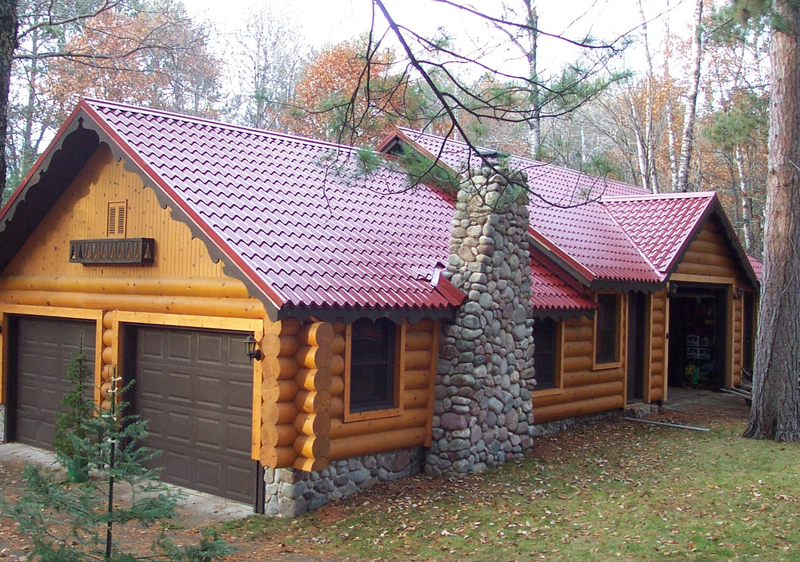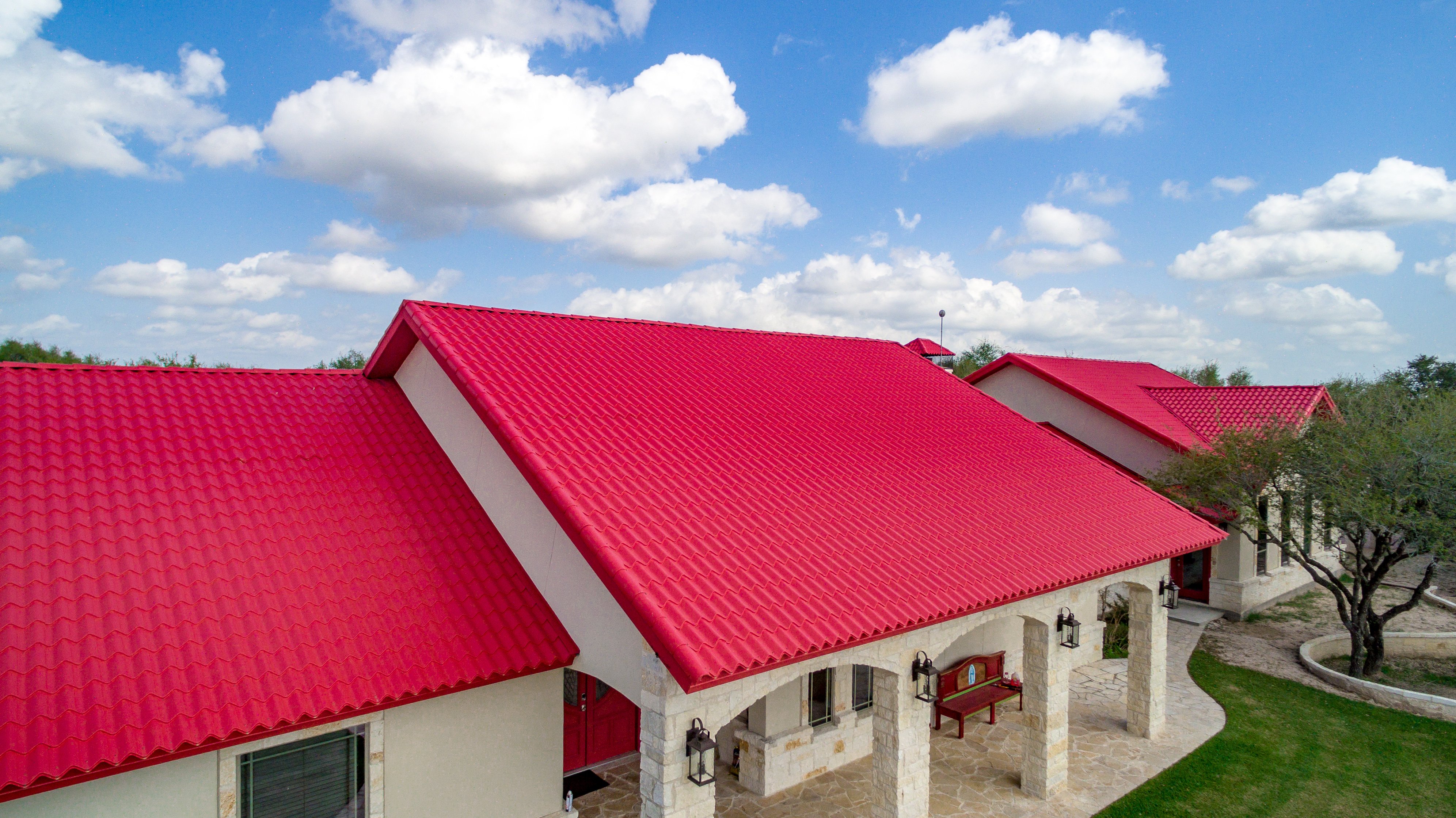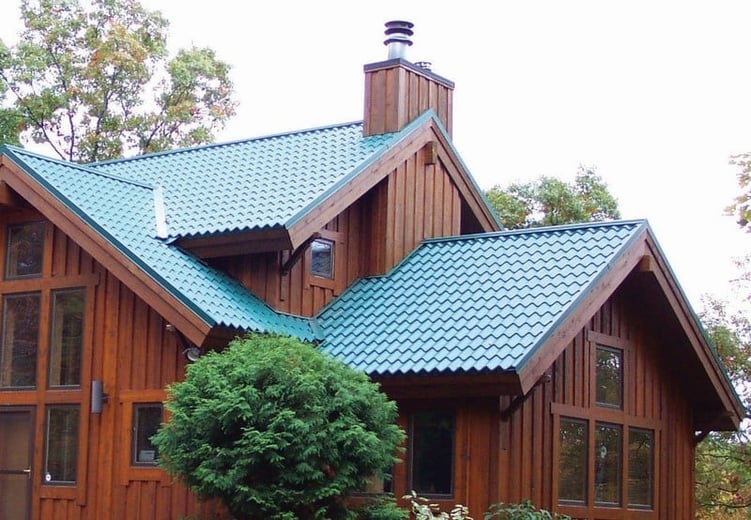Posted by McElroy Metal ● Mar 12, 2024 8:00 AM
Metal Roofs that Look Like Tile – How Do They Compare to Clay Tile?
Ceramic tile roofing, or clay tiles, have a distinctive look and are often found on buildings associated with Mediterranean and Spanish architecture. These beautiful tiles have been around for centuries; they can be traced back to 10,000 years B.C.!
Ceramic tiles add color and style to homes and provide long-lasting roofing solutions. However, they are vulnerable to cracking and breaking and offer little resistance to moisture and temperature changes.
While clay tiles were one of a few limited options in years past, the invention of metal presses and roll-formers opened up new options to homeowners. Today, you can find metal roofs that look like clay tiles while offering homeowners the superior performance you'd expect from metal panels.
Presentation
The most obvious similarity between clay tiles and tile-shaped metal roof products is the appearance of the rounded profile. They create a very similar presentation, and in fact, McElroy Metal's Met-Tile roof looks so much like traditional tile that most people are surprised to learn that they are actually metal roof panels!
In addition to the shape and profile, color is another important factor. Simply put, metal roofs offer homeowners more color choices than ceramic tiles. From bold reds and blues to classic earth tones, the metal product color palette has many beautiful options and adds curb appeal to any design.

Function
While traditional clay tiles and metal are considered "long-life" roofing systems, there are some significant differences in durability, function, and maintenance.
Clay tiles are prone to cracks and breakage, leading minimally to expensive repairs, if not leakage and damage to surrounding property. Metal roofing is renowned for being low-maintenance and unlikely to need repairs.
When deciding what material is best for your project, remember that lower-slope projects are better suited for metal panels than ceramic tiles. For example, the minimum recommended slope for clay tile falls in the 3-4:12 pitch range, while pitches as low as 1 ½":12 (using tape sealant) are feasible for metal roof styles.
Clay tiles are not typically wind-resistant, creating a dangerous scenario during high-wind weather, and they are not "weather-tight," meaning moisture can penetrate the building's substructure. Metal panels are rated “Class 4”, indicating they have undergone rigorous testing and meet impressive performance and safety standards.
Another advantage of metal panels is flexibility. Clay tiles are generally not recommended in regions with repetitive freeze-thaw cycles. In contrast, metal panels can be installed in any climate.
Ceramic tiles are also extremely heavy, typically weighing 9 ½-12 lbs. per square foot. Ceramic tile roofs need extensive support and typically require the application of vertical and horizontal wood battens between the underlayment and tiles. This framework results in extra material, labor, and transportation costs.
By contrast, metal panels weigh approximately one pound per square foot, making them a cost-effective choice due to reduced infrastructure requirements and surrounding costs. Weighing almost 90% less than clay tiles, metal can be shipped and installed at far more attractive rates.

Sustainability
Although both materials can be recycled and offer long lifespans, metal surpasses materials like ceramic tile when it comes to sustainability. Metal is superior in two aspects of sustainability: recovering existing roofs and reducing building infrastructure.
Recovering a roof is a highly advantageous and sustainable alternative to a full replacement, thanks to the minimal waste and increased insulation occurring when an existing roof is covered with new materials. Metal panels are a popular choice for recovering existing roofs, thanks to their durability and lightweight. While clay tiles can function in recover applications, they are inherently less suitable because most existing roof structures cannot support the additional weight of the tiles.
Another advantage of metal roofing is a reduced need for heavy-duty infrastructure. Light-weight roofing reduces the load placed on the building's support structure, which can sometimes allow for lighter beams, columns, and foundations, leading to cost savings on materials and construction.
Please note that if you are considering recovering existing roofing material, you should always check with a local engineer before determining structural integrity and loading abilities.
When considering sustainability, keep in mind the impact an energy-efficient roof has on the planet and your wallet. Clay tiles and metal panels both offer reflective properties that minimize heat absorption and lower energy costs. However, only one of these materials is suitable for this project when harnessing solar power. Metal panels are perfectly suited to pair with solar panel installation, and solar panels can often be directly attached to metal roofing without even penetrating the existing roof.
Installation Speed & Safety
Metal tile-shaped panels are installed much more quickly than clay tiles. While there are a few different sizes of clay tiles, most fall in the 13" x 16" size, while metal panels often cover three feet wide from eave to ridge in one continuous panel. Therefore, metal roofing significantly saves installation labor and time over clay tile roofs.

In Summary
While these two products have a similar aesthetic and many overlapping benefits, metal offers a long-term advantage. Your projects will offer the style and longevity your customers seek while reaping the benefits of metal's performance and flexibility.
For more information about the similarities and differences between clay tiles and metal roofing, check out this helpful table from the Metal Roof Alliance. You can compare several categories, including costs, expected lifespan, maintenance requirements, and more.
FAQ about Metal Roofs that Look Like Tile
This post was originally posted in June of 2022. We get lots of questions on this topic and the following are some of the most common.
1. Are there any specific environmental benefits associated with metal roofs that imitate the appearance of tile, such as energy efficiency or sustainability factors, compared to traditional clay tile roofs?
Metal roofs that imitate the appearance of tile offers superior environmental benefits compared to traditional clay tile roofs. For instance, metal roofs typically have higher solar reflectance, meaning they can help reduce cooling costs by reflecting more sunlight away from the building.
Metal roofing materials are fully recyclable at the end of their lifespan and require less energy for production.
2. How do the costs associated with long-term maintenance and repairs differ between metal roofs designed to mimic tile and clay tile roofs, particularly regarding repairability and replacement of damaged sections?
The costs associated with long-term maintenance and repairs can vary between metal roofs that mimic tile and clay tile roofs. While both materials are generally durable, metal roofs may require less maintenance and repair over time due to their resistance to pests, mold, and mildew.
Metal panels can often be replaced individually if damaged, whereas clay tiles may require more extensive repairs or replacements of entire sections. However, it's essential to consider factors such as the quality of installation and the specific climate conditions in determining the long-term maintenance costs for each roofing material.
3. Are there any regional considerations or limitations for installing metal roofs that resemble tile, such as building codes or environmental conditions, that homeowners should be aware of before making a decision?
Regional considerations and limitations for installing metal roofs resembling tile can play a significant role in homeowners' decision-making. Building codes, environmental conditions, and local climate factors may impact the suitability of metal roofing in certain regions. For example, areas with high wind or extreme weather conditions may have specific requirements for roofing materials to ensure structural integrity and safety.
Some homeowners associations or historical preservation districts may have regulations or guidelines regarding using certain roofing materials to maintain the aesthetic consistency of the neighborhood. Therefore, homeowners must consult with local authorities and roofing professionals to understand regional considerations or limitations before installing a metal roof mimicking tile.
Learn everything you need to know about Residential Metal Roofing. Check out our metal roofing resources for inspiration and answers to your questions.
About McElroy Metal
Since 1963, McElroy Metal has served the construction industry with quality products and excellent customer service. The employee-owned components manufacturer is headquartered in Bossier City, La., and has 14 manufacturing facilities across the United States. Quality, service and performance have been the cornerstone of McElroy Metal’s business philosophy and have contributed to the success of the company through the years. As a preferred service provider, these values will continue to be at the forefront of McElroy Metal’s model along with a strong focus on the customer.
Topics: Education, Metal Roofing, FAQ, Met-Tile
Comments on this article:
Scroll down to the bottom to submit a comment and join the conversation. Need help or have a question? Please contact us. Looking for a distributor or contractor? Please click here to get started.






%20(002).png)
